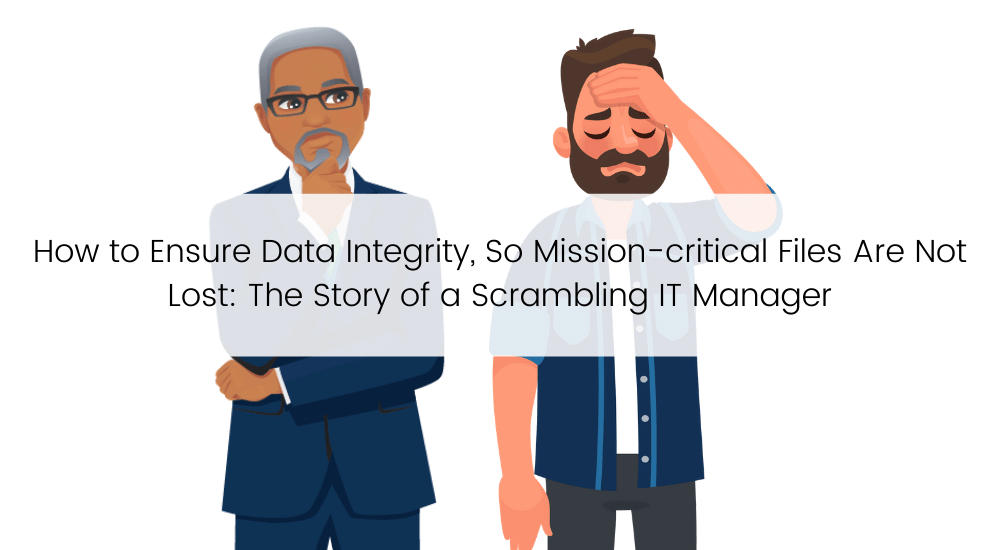
Fredmund is an IT guru supporting a flourishing enterprise. He's the go-to guy for all things IT and well-loved for helping multiple teams at several locations. He's capable. And talented. And now angry.
Following a massive data migration project completed by a third-party vendor, Fredmund is asked to find a crucial digital folder. Now. The folder contains production schematics and proprietary data for a doohickey product scheduled to launch next month.
His data backups are regularly scheduled and he’s sure the documents are secure. He fights the urge to roll his eyes at the request and prioritizes it anyway. But after searching unsuccessfully for the critical files, self-doubt about his backup processes begins to take hold.
He can't find the folder.
The search becomes a controlled panic as his phone pings with requests (demands) for updates. What's the restoration time on the data, Fredmund? In one glance, he sees the empty coffee pot and the battery icon on his laptop blinking red. He decides the battery is more important than the coffee and struggles to find his charger. His boss calls. He misses it because he's fighting dust bunnies behind his desk.
Although desperate for coffee, his lurching stomach needs no further agitation. He finally discovers that someone has inadvertently deleted the entire folder. All of the product updates from the last 8 months are gone. Forever.
A single folder worth $2 million of critical business data – intellectual property, design changes, and production plans. Gone. The product launch date will be delayed, and the company will take a financial and reputational hit, . . . and Fredmund?
He is angry. Who is to blame? How is he going to tell his boss? His boss's boss? Is this the resume-generating event that the IT newbies talk about? How could he have made a mistake? The backup reports were green. But . . . he had never validated the integrity of the data and had missed including that folder in his regular backups.
He is angry with the delete-happy employee and himself for not creating an immutable backup – one that would have saved the files despite the data migration project.
To err is human, to make sure you can recover from mistakes is to test, validate, test, and validate again.
Data Backup and Recovery: Strategies to Validate the Integrity of Your Data
Are you willing to bet your entire business and reputation on your current data backup and recovery strategy? Wait, do you even have a strategy? Varonis research estimates that “every employee has access to 11 million files.” That is 11 million invitations to disaster. After an incident, do you trust your restoration procedures to fully restore your data from the cloud, data centers, and disks to make your business whole again?
When you need to be absolutely, positively sure that your essential data is recoverable, validating the integrity of data is mission-critical to your business. Successful testing in test environments does not qualify as a success. Companies need clean data to operate and drive profit.
Data does not live in a vacuum. Data sprawl is a real thing, and critical data needs to be onboarded correctly, or it can be missed in backups and reporting.
Digital disruptions are inevitable. Expect them. But be prepared.
Create a data backup strategy that outlines policies and procedures to encompass a backup program's technical components and the protection of the business enterprise. It is essential to gain visibility across the entire environment you need to protect. Conduct discovery to find assets, set a governance model, and a backup frequency plan. Analyze reports to verify coverage. And VALIDATE THE INTEGRITY OF YOUR DATA.
As a trusted MSP, TBConsulting can build and manage your organization's critical backup and recovery program with our Backup as a Service (BaaS) solution. We work to align your enterprise policy with IT controls to deliver innovative risk management solutions. We are proud of our commitment to helping businesses develop and maintain a robust data protection strategy.
So, what can TBC's BaaS solution do for Fredmund?
- 24/7 support during recovery efforts
- BaaS experts aligned with your IT strategies
- Verify backups are recoverable – meeting RPO/RTOs
- Protect servers, user files, and databases
- Backups deployed to the cloud or offsite to reduce on-prem infrastructure
- Reporting on backup status
And what can TBC's BasS solution do for Executives?
- Outline proof-positive recovery procedures as a critical component of business continuity planning
- Opex vs. Capex
- Define and implement data protection measures
- Reduce infrastructure footprint and costs with cloud-based backup
- Restore business operations and critical infrastructure
- Meet compliance or regulatory requirements for data backups
Ignorance is not bliss.
We can help.
.png)

